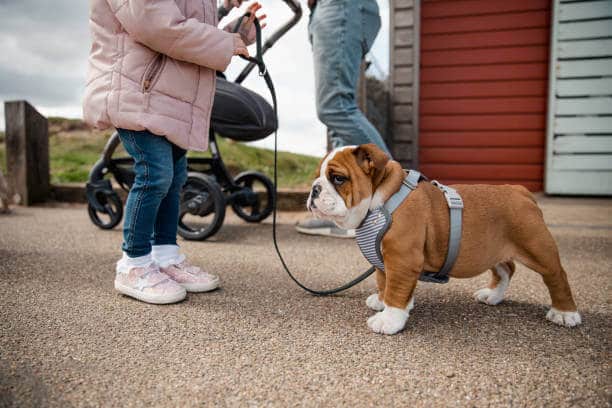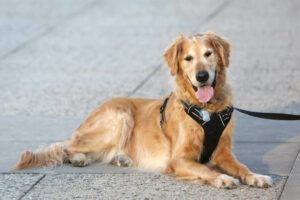In Today’s article we will cover some great tips for putting on a dog harness.
A harness is the best way to walk your dog. Harnesses are complex for dogs to slip from and protect them against neck strain for pullers. Dog handlers will find it easier to walk their dogs on a leash with harnesses. They reduce the desire to pull the dog and make it easier to correct it.
Putting on a harness first can be challenging, especially if your dog doesn’t like new things. This answer will show you how to attach a harness to your dog. It will make it easier for you both to enjoy safe and comfortable walks together.
Every dog owner should have a harness. It is essential to know how to put it on properly. Find all the details about how to attach a dog harness (including different types) below!
Step-by-step instructions on how to attach a dog harness:
What Type of Dog Harness is Right for You?
Many types of harnesses are available, so it might take some time to find the right one for you.
The way the harness attaches to the harness can be a distinguishing factor. The leash attachment point is the more important of the two methods to distinguish your dog. It will affect how you manage him.
Let’s look at three of the most popular types of harnesses.
Dual-Clip Harness
A dual-clip harness is an excellent place to start if you aren’t sure where your dog will be most comfortable.
Dual-clip harnesses allow you to attach the leash to the right place by having clips at the front or back.
Back-Clip Harness
A back-clip harness attaches the dog’s leash to a loop usually placed between the shoulder blades. These harnesses are great for small dogs because they don’t get in the way of their legs and give you complete control over the dog.
Front-clip Harness
These harnesses are great for controlling your dog. However, front-clip harnesses can get caught on the dog’s legs if there’s too much leash slack. That can cause frustration for you and your dog, especially if you plan to run with your dog.
It attaches to the harness’ front so that your dog can pull on the leash. You can then redirect his back towards you by attaching the leash to his harness.
Front-clip harnesses are equipped with a leash attachment that attaches to the dog’s chest. You can use these harnesses to stop pulling dogs.
Step #1 – Allow your dog to sniff the dog harness.
It is a simple way for your dog to get used to the harness. It will hopefully reduce some anxiety associated with the first time your dog wears a harness.
Let your dog inspect the harness before you put it on. You can hold the harness high for your dog to check or place it on the ground so that he can explore the bizarre contraption at his own pace.
Step #2 – Have your dog sit calmly beside you.
If your dog is calm, it will be easier to put on the harness. Before you put on the harness, make sure your dog is calm and not jumping around.
Step #3 – Use an over-the-head harness to secure the harness.
There are various types of harnesses available today, so the steps required to attach your harness can vary. Some harnesses can be used quickly, while others require multiple fastening points.

Using a step-in dog harness; put your dog’s paws through each triangle on the chest strap. Next, secure the harness around your dog’s neck.
Tuck the chest piece under the dog’s chest if you are using a chest harness. Next, attach the straps to your dog’s back behind his front legs.
Step #4 – Make sure the harness is correctly oriented
It is easiest to identify the location of the D-rings you attach the harness to. You will usually find one on your dog’s chest or the strap resting on his back. Some harnesses combine both.
It’s easy for a puppy to get confused by the various straps when they are new.
Step #5 – Once the dog harness has been placed on your dog, adjust it to make sure it fits properly.
Your dog’s harness should fit snugly enough that it doesn’t slip from his neck, whether he is lying down or sitting. You want your dog to feel comfortable with the harness, but at the same time, it should not slip off. It should be easy for you to fit two fingers under any harness strap.
Take a moment to observe your dog wearing the harness and note any problems.
Is it looking like the harness may be falling off? Does it seem to be sagging in any particular area? Are you limiting your dog’s movement?
Step #6 – Make sure your GPS dog tracker is securely fastened to your harness before you leave home.
GPS allows you to monitor the activity of your dog, which can help you determine their normal. You can also set goals and note sudden changes.
GPS has an unlimited range and lets you track your dog if he goes off independently. To track your dog in real-time, ensure to switch to LIVE Mode within the app.
For consistent tracking, ensure that the tracker is pointed towards the sky. You can also slip the tracker into a pouch if your harness has one.
Step #7: Give Incentives.
You can explore positive reinforcement, such as praise and treats, to calm your dog if he is resistant to the harness. It may take some practice to secure the harness. You might reward him by putting the harness around his neck the first time.
Once your dog is comfortable, you may begin to buckle one of the straps. Depending on how comfortable your dog is, it may take several days to attach the harness fully. You’ll eventually get there if you are patient and give lots of praise.
Let your dog wear the harness for a few minutes around the house. You can then observe your dog, make any adjustments, and take note of any problems.
To reinforce good behavior, praise your dog and give him treats once the harness has been attached. You may find your dog uncomfortable wearing the harness. If you honor him, he will soon feel at ease and realize that everything is okay.
Extra Tips To Help You Put On A Dog Harness
- It may take some practice to secure the harness around your dog.
- Please don’t wait to take your dog on a walk before you introduce a harness to him. It will only lead to stress for you both.
- You will find your dog anxious to go for a walk and frustrated that you aren’t getting him to cooperate with your efforts to attach the harness. Instead, let your dog wear the harness around the house to get used to it.
- You can try the harness on in the comfort of your own home.
It may take several attempts to get your dog to buckle the harness if he is anxious or fidgety.
You must ensure the harness is adjusted correctly.
You wouldn’t want your dog to slip out of his harness while you go on walks.
Never leave your house until you feel the right fit.
Dog Harness Conclusion
It’s essential to be patient when you first learn how to attach a harness to a dog. You be rest assured that your dog will cooperate and things will go smoothly. If that is not the case, you can keep trying and provide lots of positive reinforcement.
Did you find this article useful? Feel free to share your thoughts. We would be happy to hear from you!
Stay tuned for more posts on dog care and much more!
“May Your Home Be Filled With Love And Dog Hair”
Any/all links on this site may be affiliate links, and if you make a purchase through one of them, I will earn a small commission at no extra cost to you. Read the full affiliate disclosure here.
“As an Amazon Associate, I earn from qualifying purchases.”
Mark
Founder of Our Dogs World 101



I was wondering why my dog sniffed the old harness we had. And one of my first mistakes was to not orient the harness correctly.
I want to buy a good harness that helps me control my dog. So, I have figured out that my best choice is an Eagloo dog harness.
The Eagloo is definitely a great choice.
I love how people really take care of their dogs. They treat them like humans and I absolutely love it. I want to get a dog so this is a product I will definitely look into getting. Thank you for this article. I have definitely bookmarked it and I will come back to it closer to the time
Yes dogs are definitely family in my eyes!
Thanks for your post. I used to own 2 JRTs. Now I have one. One of them is super feisty and she doesn’t like me to put on her harness. I keep it on her though. I used to try to walk both by leash with their collars on. They pulled all the time and it would choke them because they strained against them. Once I switched to a harness, walking them became easier. I like your suggestion that we need to be patient when trying to put the harness on our dogs. I don’t have patience, that’s why I keep the harness on my Jill. I also like your suggestion not to wait until it’s time for a walk to introduce your dog to the harness. I learned that the hard way. I would wait and then it would take me forever to get the harness on her. By then, I would be angry and she would be scared because I’d be screaming. Thanks for your post.
Thanks for your comment Shalisha